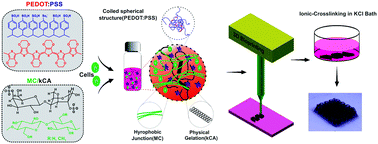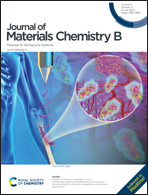3D printing of cell-laden electroconductive bioinks for tissue engineering applications†
Abstract
Bioprinting is an emerging powerful fabrication method, which enables the rapid assembly of 3D bioconstructs with dispensing cell-laden bioinks in pre-designed locations. However, to translate this technology into real applications, there are still a number of challenges that need to be addressed. First, the current inks are generally composed of polymeric materials with poor electrical conductivity that mismatches with the native tissue environment. The second challenge associated with the 3D bioprinting of hydrogel-based bioinks is the fabrication of anatomical-size constructs without any loss of shape fidelity and resolution. To address these challenges, in this work, we introduced a biocompatible bioink associated with current 3D bioprinting by combining methylcellulose and kappa-carrageenan (MC/κCA) hydrogels with poly(3,4-ethylenedioxythiophene):poly(styrenesulfonate) (PEDOT:PSS) conducting polymers. The prepared ink exhibited highly thixotropic behaviour, which could be tuned via changing the concentration of MC and κCA to obtain easy printing with high shape fidelity. The ink was able to fabricate physiological-scale constructs without requiring a secondary support bath. In addition, varying the concentration of PEDOT:PSS could control the electrical conductivity of the ink. Moreover, the encapsulated human embryonic kidney 293 (HEK-293) cells in bulk hydrogels and 3D bioprinted structures maintained high cell viability (>96%) over a week, confirming the in vitro biocompatibility of the ink. Overall, these findings indicate that the MC/κCA/PEDOT:PSS bioink can be promising in biomedical applications, which improved the electroconductivity of bioinks and can exploit the advantage of conductive polymers in the 3D bioprinting technology.

- This article is part of the themed collections: Editor’s Choice: Tissue Engineering and 2020 Journal of Materials Chemistry B most popular articles


 Please wait while we load your content...
Please wait while we load your content...